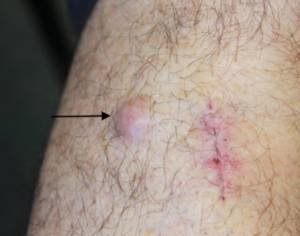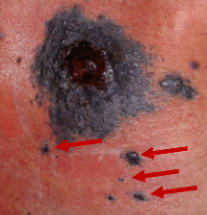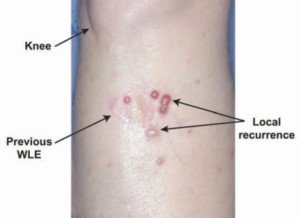A small number of patients will get a local recurrence of melanoma very near to the excision site.
Do you know what a local recurrence looks like?
First off, it’s always possible that a new primary tumor can develop, by sheer chance, right beside the site of a surgically removed melanoma.
The second tumor in this case will have nothing to do with the first.
However, a local recurrence of a melanoma has a more finite range of appearances.
Suspicious Signs of Local Recurrence of a Melanoma
“Cutaneous melanoma may recur locally after surgical excision, either as an in-transit metastasis or as a satellite recurrence,” says Kara Shah, MD, an adult and pediatric dermatologist and founder of Kenwood Dermatology in Cincinnati, OH.
“Under both circumstances, recurrence occurs as a result of microscopic foci of melanoma cells within the skin [subcutaneously] or lymphatic vessels that were not removed during the surgery,” continues Dr. Shah.
“A satellite recurrence will appear as one or more pink or brown bumps within the surgical scar or within normal skin located two cm or less from the surgical scar.
“An in-transit recurrence, which results from the proliferation of residual melanoma cells that have spread through the lymphatic vessels in proximity to the tumor site, appears as one or more pink or brown bumps located two cm or more from the surgical scar at the site of the previously excised melanoma — but which have not reached the local lymph nodes.”

Local skin metastasis (above)

Satellite metastases (red arrows, above). The large legion is an untreated primary tumor.

Local recurrence (above)
Other Features to Look Out For
• Recurrence of melanoma usually grows rapidly.
• The lesions are usually firm and hard. But don’t ignore a bump if it’s soft.
• Pink and brown are the going colors, but don’t breathe a sigh of relief if new bumps are bluish, grey or black.
• “The skin lesions of a local recurrence may ulcerate or bleed,” says Dr. Shah.
A metastatic recurrence of the in-transit metastatic type looks the same whether it’s three cm from the excision site or on a different body part.
Local Recurrence and Distant Metastasis
“A local recurrence, which can be either an in-transit or satellite recurrence, looks the same as a distant metastasis arising on the skin of a different body part,” explains Dr. Shah.
“An in-transit metastasis occurs via dissemination of melanoma cells along lymphatics and therefore occurs in a loco-regional distribution (on the same body part as the primary melanoma). This is considered stage III disease.
“Metastatic melanoma arising on a different body part or an internal organ would be a distant metastasis and this occurs via hematogenous dissemination through the blood vessels. This is considered stage IV disease.”




























